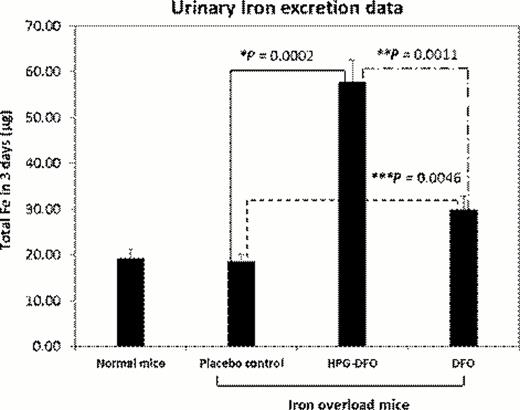Abstract
Abstract 486
Transfusion dependent patients with abnormal hemoglobins or bone marrow failure syndromes require treatment to prevent and reverse iron overload. Desferrioxamine (DFO) mesylate is effective in promoting iron excretion. However, its usefulness is limited by a short intravascular half-life (t1/2) which necessitates continuous 8–12 hr subcutaneous infusion, often leading to limited patient compliance. Using hyperbranched polyglycerol (HPG), we have generated DFO conjugates which have significantly prolonged t1/2, good tolerance and improved iron excretion efficiency in mice.
HPGs with molecular weight (MW) of 50 to 700 kDa were conjugated to varying numbers of DFO molecules (25–400) using Schiff-base chemistry. The influence of HPG MW and DFO density on DFO iron binding was determined using UV-visible spectroscopy. The safety of HPG-DFO was evaluated by examining activated partial thromboplastin time (APTT), prothrombin time (PT), thromboelastography (TEG), platelet activation and complement activation. The effect of HPG-DFO on cell viability was evaluated in human umbilical vein endothelial cells (HUVECs). Single dose tolerability in mice was studied by injecting up to 1000 mg/kg of HPG-DFO and monitoring body weight, lactate dehydrogenase level and histological examination of organs at 14 days. Tritium labeled HPG-DFO was used to determine the circulation t1/2 in mice. Iron excretion efficacy of HPG-DFO compared to DFO was tested in iron overloaded mice by treating the animals with 150 mg/kg DFO or DFO equivalent. The iron content of organs, urine and feces was analyzed to determine the amount of iron excreted. Histological examination of the organs was performed using the Prussian blue stain.
Spectroscopic analysis demonstrated that the conjugation of DFO to HPGs did not change their iron binding properties; the maximum absorption was at 429 nm for every conjugate tested. HPG-DFOs did not activate platelets, coagulation or the complement system. In vitro cell tolerance studies showed there was no increase in toxicity compared to the DFO molecule after polymer conjugation. Mice tolerance studies showed that the HPG-DFO conjugates were non toxic up to the maximum injected dose of 1000 mg/kg. The t1/2 of HPG-DFO in normal mice was 16 h for the 50 kDa conjugate and 44 h for the 500 kDa conjugate. The iron excretion efficiency as measured by urinary iron of the 50kDa HPG-DFO in iron overloaded showed significant improvement compared to placebo (58 Ìg vs 19 Ìg, p=0.0002) and DFO treated mice (58 Ìg vs 30 Ìg, p=0.0011 Figure 1).
HPG-DFO conjugate chelators were well tolerated in mice with significantly improved t1/2 and iron excretion. This approach has the potential to significantly decrease the number and duration of injections required to offload significant amounts of organ and total body iron. Further studies to determine the optimal conjugate and dose of agent are currently ongoing.
Comparison of urinary iron excretion from iron overloaded mice for DFO and an HPG-DFO conjugate (50 kDa, 80 molecules of DFO). Total urine collected on day 9, 14 and 21 was analyzed for iron excretion using inductively coupled plasma mass spectrometry (ICP-MS).
Comparison of urinary iron excretion from iron overloaded mice for DFO and an HPG-DFO conjugate (50 kDa, 80 molecules of DFO). Total urine collected on day 9, 14 and 21 was analyzed for iron excretion using inductively coupled plasma mass spectrometry (ICP-MS).
No relevant conflicts of interest to declare.
Author notes
Asterisk with author names denotes non-ASH members.


